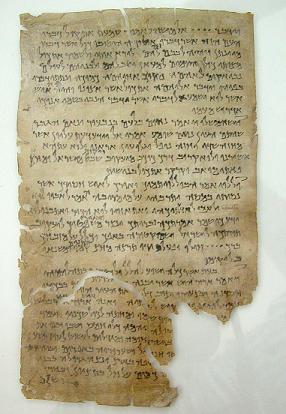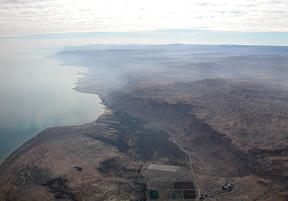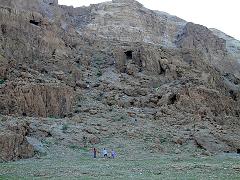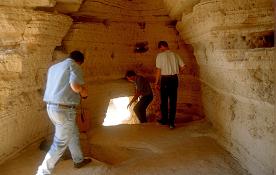|
|
|
Is the Bible Reliable?
The Original Manuscripts Ancient books, like the Bible, typically or totally do not have any surviving original manuscripts. As you will see below, only varying quantities of ancient copies of them exist. So then there are no known original manuscripts of any of the books of the Bible. All we have are ancient copies of the originals. Why have the originals perished? Two things are likely: (1) they needed recopying because the material on which they were written degraded and deteriorated, and (2) they were destroyed by the copyists after they made a new copy from them. One thing we know for sure is that the Good News message within the Bible is more important than the technicalities of how we actually got a copy of it. For example, the Bible says, “Faith comes from hearing, and hearing by the word of Christ.” (Ro 10:17) This verse teaches that a person can learn to trust God by listening to the story of Jesus Christ, and not primarily by studying historical evidence or lack thereof. Faith comes by hearing, not by seeing (Ro 10:17). After reading the Bible for yourself, then by faith you may begin to trust that the Bible is from God. It is the message in it that convicts and convinces people that the Bible is true, reliable, and trustworthy. Belief in the Son of God does not come by any other means than hearing the message of Him.
Ancient books, like the Bible, typically or totally do not have any surviving original manuscripts. As you will see below, only varying quantities of ancient copies of them exist. So then there are no known original manuscripts of any of the books of the Bible. All we have are ancient copies of the originals. Why have the originals perished? Two things are likely: (1) they needed recopying because the material on which they were written degraded and deteriorated, and (2) they were destroyed by the copyists after they made a new copy from them. One thing we know for sure is that the Good News message within the Bible is more important than the technicalities of how we actually got a copy of it. For example, the Bible says, “Faith comes from hearing, and hearing by the word of Christ.” (Ro 10:17) This verse teaches that a person can learn to trust God by listening to the story of Jesus Christ, and not primarily by studying historical evidence or lack thereof. Faith comes by hearing, not by seeing (Ro 10:17). After reading the Bible for yourself, then by faith you may begin to trust that the Bible is from God. It is the message in it that convicts and convinces people that the Bible is true, reliable, and trustworthy. Belief in the Son of God does not come by any other means than hearing the message of Him.
Ancient Copy & Textual ProofsCompare it to any other ancient book, and you will see that the Bible is by far, overwhelmingly, and beyond a doubt (1) the best supported by ancient copies and (2) the best preserved textually. For example:1. Compare It to the Total Surviving Copies, Not Originals, of Various Other Ancient BooksAUTHOR # OF EXTANT [existing] COPIES Caesar Gallic Wars 10 copies Livy Roman History 20 copies Tacitus Annals 20 copies Pliny Secundus History 7 copies Thucydides History 8 copies Suetonius de Vita Caesarun 8 copies Herodotus History 8 copies Lucretius 2 copies Catullus 3 copies Euripides 9 copies Sophocles 193 copies Demosthenes 200 copies (all from one copy) Aristotle 49 copies (of any one work) Aristophanes 10 copies“In the entire range of ancient Greek and Latin literature, the ILIAD ranks next to the New Testament in possessing the greatest amount of manuscript testimony.” [(Metzger, 144) Metzger, Bruce M., Chapters in the History of the New Testament Textual Criticism, Grand Rapids MI,Wm. B. Eerdmans Publishing Co., 1963] How many extant [existing] copies are there of Homer’s ILIAD? Homer ILIAD643 copies That is a remarkable figure. It results partly from the Greeks esteem for the ILIAD, which they regarded as holy. Now consider the even more amazing number of ancient copies available for the N.T. New Testament over 5000 Greek copies
over 10,000 copies in Latin
over 4,000 copies in Slavic
over 2,000 copies in Ethioptic
over 2,000 copies in Armenian
over 350 copies in Syriac; etc.
Note: Lest we seem to exaggerate, we have understated figures in this chart. The authoritative Kurzgefasste Liste der grieschischen Handschriften des Neuen Testaments (1994), edited by Kurt and Barbara Aland, lists the following figures for Greek manuscripts of the New Testament: papyri 99; uncials 306; miniscules 2855; lectionaries 2396; total Greek: 5656 (McDowell, NEDV, 36). More recent research by journalist Lee Strobel shows the following: papyri 99; uncials 306; miniscules 2856; lectionaries 2403; total: 5664. [(Strobel, 62-63), Strobel, Lee, The Case for Christ, Grand Rapids: Zondervan, 1998] Counts may vary slightly depending on how fragments are classified.
Fittingly, Sir Frederick G. Kenyon of the British Museum said, “No other ancient book has anything like such early and plentiful testimony to its text, and no unbiased scholar would deny that the text that has come down to us is substantially sound.” “Scholars are satisfi ed that they possess substantially the true text of the principal Greek and Roman writers whose works have come down to us, of Sophocles, of Thucydides, of Cicero, of Virgil; yet our knowledge of their writings depends on a mere handful of manuscripts, whereas the manuscripts of the New Testament are counted by the hundreds and even thousands.” [(Kenyon, 20) The Bible and Modern Scholarship, London: J. Murray, 1940]; [(Kenyan, 23) Kenyan, Frederick, Our Bible and the Ancient Manuscripts, 4th ed. London: Eyre and Spottiswoode, 1939] 2. Compare It to the Textual Integrity of Other Ancient Books“This discussion cannot be fully appreciated unless it is contrasted with the textual integrity of other books from the ancient world… Only 40 lines (or 400 words) of the New Testament are in doubt whereas 764 lines of the ILIAD are questioned. This five percent textual corruption compares with one-half of one percent of similar emendations in the New Testament. [In] the national epic of India, the Mahabharata,… some 26,000 lines are textual corruptions (10 percent). The New Testament, then, has not only survived in more manuscripts than any other book from antiquity, but it has survived in a purer form than any other great book – a form that is 99.5 percent pure.” [(Geisler, 366-367) Geisler, Norman L. and William E. Nix, A General Introduction to the Bible, Chicago: Moody, 1986 (latest edition 1986)]3. Ancient Copies Testify to Its AccuracyMany Bibles are translated into modern day languages from the earliest copies of Hebrew, Aramaic, and Greek Scriptures. For example:
The Conclusion Is ThisWe can be sure that even though we do not have the original manuscripts (evidently no ancient book does), we do have reliable and remarkably accurate copies that were made from them.BACK TO INTRO HOME PAGE Website & Bible study content Copyright 2001-2010, © Patrick David Yanello, All rights reserved. |
 The Dead Sea Scrolls are an interesting Old Testament copy. They were discovered, supposedly, in 1947 by an Arab shepherd boy who threw a stone into a hillside cave, a Qumran cave near the Dead Sea in the Middle East, and heard what sounded like the breaking of pottery. He went into the cave and found pottery jars that contained carefully wrapped scrolls. More than one third of these scrolls are books of the Old Testament. They were hidden for over 2,000 years and are considered to be older by at least 1,000 years than
The Dead Sea Scrolls are an interesting Old Testament copy. They were discovered, supposedly, in 1947 by an Arab shepherd boy who threw a stone into a hillside cave, a Qumran cave near the Dead Sea in the Middle East, and heard what sounded like the breaking of pottery. He went into the cave and found pottery jars that contained carefully wrapped scrolls. More than one third of these scrolls are books of the Old Testament. They were hidden for over 2,000 years and are considered to be older by at least 1,000 years than
 the earliest known Old Testament Hebrew copies that the Jews use to translate from, such as The Cairo Codex 895 AD., and The Leningrad, now St. Petersburg Codex of the Prophets 916 AD.
One of the best preserved scrolls is the O.T. book of Isaiah. It is estimated to be second century B.C. It agrees in almost every respect with other traditional Hebrew texts, like the ones used in translating the King James Version. The Isaiah Scrolls
“proved to be word for word identical with our standard Hebrew Bible in more than 95% of the text.
The 5% variation consisted chiefly of obvious slips of the pen and variations in spelling.” [(Archer, 19), Gleason Archer,
the earliest known Old Testament Hebrew copies that the Jews use to translate from, such as The Cairo Codex 895 AD., and The Leningrad, now St. Petersburg Codex of the Prophets 916 AD.
One of the best preserved scrolls is the O.T. book of Isaiah. It is estimated to be second century B.C. It agrees in almost every respect with other traditional Hebrew texts, like the ones used in translating the King James Version. The Isaiah Scrolls
“proved to be word for word identical with our standard Hebrew Bible in more than 95% of the text.
The 5% variation consisted chiefly of obvious slips of the pen and variations in spelling.” [(Archer, 19), Gleason Archer,
 A Survey of the Old Testament Introduction, Chicago: Moody, 1977]
So this proves, by 1,000 years or more, that the copy making process was very reliable.
Because the Dead Sea Scroll book of Isaiah almost entirely matches other more current copies, we have much more confidence in the copy making process used by scribes over the centuries. These scrolls are an ancient testimony to the accuracy of today’s Bibles.
A Survey of the Old Testament Introduction, Chicago: Moody, 1977]
So this proves, by 1,000 years or more, that the copy making process was very reliable.
Because the Dead Sea Scroll book of Isaiah almost entirely matches other more current copies, we have much more confidence in the copy making process used by scribes over the centuries. These scrolls are an ancient testimony to the accuracy of today’s Bibles.